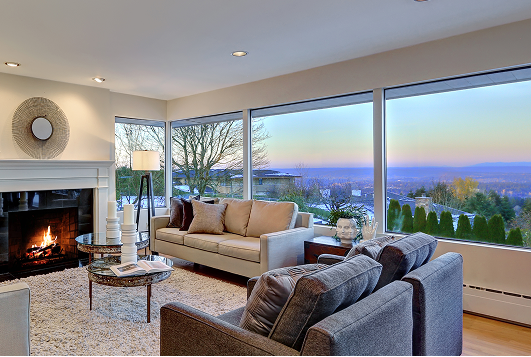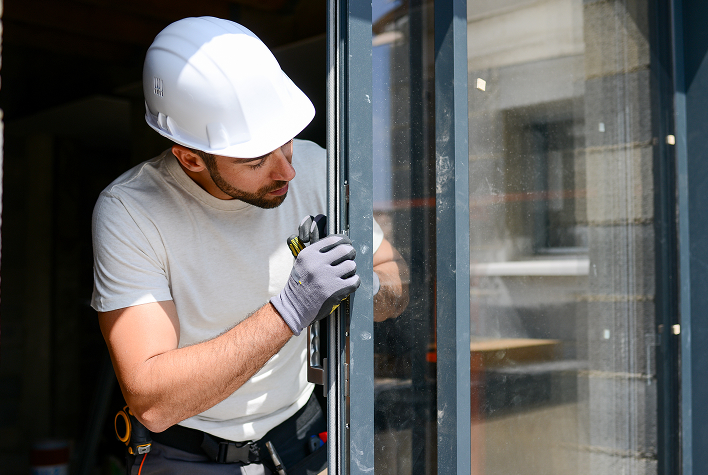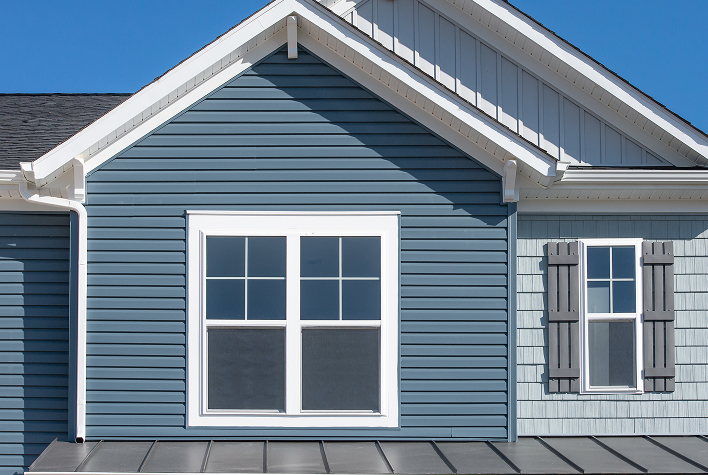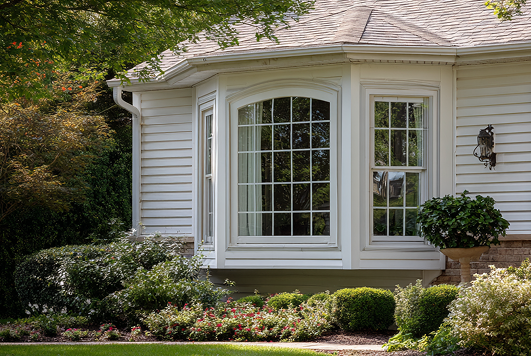Key Points
- Replacement windows fit existing frames, boosting comfort, efficiency, and curb appeal.
- Replace when you see drafts, condensation between panes, damage, sticking sashes, or rising bills.
- Price varies by window type, size, glass options, frame material, labor, and access, expect $8,250 to $33,000.
- Pro installation preserves warranties and performance; DIY is possible but risks leaks and inefficiency.
- Save by choosing standard sizes, comparing quotes, timing purchases off-season, and considering financing or incentives.
What Is a Replacement Window?
A replacement window is a new window designed to replace an old one in an existing frame. Unlike new construction windows, installed during a home build or major remodel, replacement windows are specifically made to fit into the current window. This makes installation quicker and often more affordable since there’s no need to remove exterior materials like siding or trim.
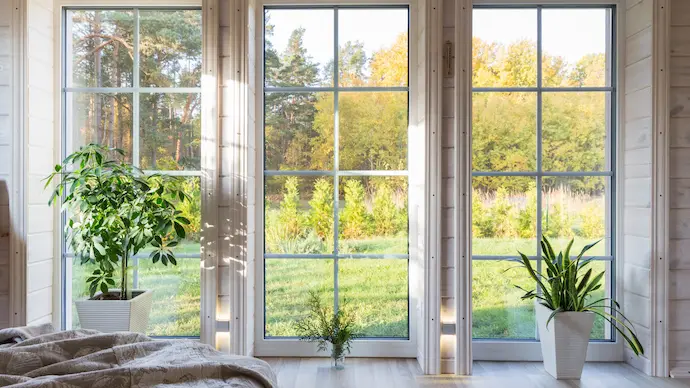
But don’t be fooled into thinking that these windows are a simple swap. They can significantly upgrade your home’s look and performance. Many replacement windows are designed with energy efficiency in mind, featuring double or even triple panes that can help keep your home warmer in the winter and cooler in the summer. Some also come with low-emissivity (Low-E) glass, which can block harmful UV rays while still letting natural light in.
Curious about the benefits? Beyond improving your home’s energy efficiency, replacement windows can boost your property’s curb appeal and increase its resale value. Plus, newer models often require far less maintenance than older ones. Vinyl windows, for example, don’t need to be repainted or resealed regularly. And if you’re tired of struggling to open those old, stuck windows, you’ll love the smooth operation of a modern window.
Considering how much time we spend in our homes, upgrading to replacement windows can make a noticeable difference in your everyday comfort. Ever noticed drafts near your windows or a rise in your energy bill during extreme weather? That’s where replacement windows can really shine. They’ll help regulate the temperature inside your home, giving you a cozier, more comfortable space while also helping you save on energy costs.
But why choose replacement windows over a full replacement? The main advantage is simplicity. They can often be installed without disturbing the surrounding trim or siding, making for a quicker, less disruptive, and often more cost-effective upgrade.
When Should You Need to Replace Your Windows?
Windows aren’t meant to last forever. Like any part of your home, they age and show signs of wear and tear. But how do you know when to get rid of your old windows and invest in new ones? Knowing the signs that your windows are past their prime is key to deciding when a replacement is necessary.
-

Drafts and Poor Insulation
Ever feel a cold draft even when your windows are tightly closed? This is one of the biggest indicators that your windows are no longer doing their job. Gaps or leaks around the window frame can let cold air in during winter or let cool air escape in the summer, causing your energy bills to skyrocket. New windows with better insulation can fix this problem and make your home more energy efficient.
-

Visible Damage or Decay
If you see cracked glass, rotting frames, or noticeable water damage around your windows, it’s time to replace them. This kind of wear and tear can allow water and moisture to seep in, which might lead to bigger problems like mold and structural damage. Replacing damaged windows not only restores your home’s appearance but also prevents future headaches.
-

Difficulty Opening or Closing
Do your windows stick, jam, or refuse to budge altogether? Windows should operate smoothly. If they’ve become difficult to open or close, it’s likely due to warped frames or damaged hardware. While you might be able to fix this in some cases, frequent issues with the operation are a sign that it’s time for a replacement.
-

Condensation Between the Glass Panes
Notice fog or condensation trapped between your window panes? That’s a sure sign of a failed window seal. The insulating gas that keeps your windows energy-efficient has likely leaked out, reducing their effectiveness. Not only does this make your windows less energy-efficient, but it can also lead to mold growth and further deterioration.
-

Outside Noise Getting In
Do you hear more outside noise than you used to? Maybe traffic, barking dogs, or your neighbor’s lawnmower? Old windows, particularly single-pane ones, offer little sound insulation. Replacing them with double- or triple-pane windows can help reduce outside noise and create a quieter, more peaceful home environment.
-

Rising Energy Bills
If your energy bills keep climbing despite no change in your energy usage, your windows could be the culprit. Older windows, especially single-pane ones, aren’t as energy-efficient as modern models. Upgrading to energy-efficient windows could reduce your energy consumption and save you money each month.
-

Renovation Projects
If you are renovating your home, replacing old windows can enhance both the appearance and value of your property. New windows can provide a modern look while improving energy efficiency.
-

Age of Windows
Windows typically serve 15 to 20 years. If your windows are older than this, especially if they are over 20 years old, they may not be energy efficient and should be considered for replacement.
Major Factors Affecting the Cost of Installing Replacement Windows
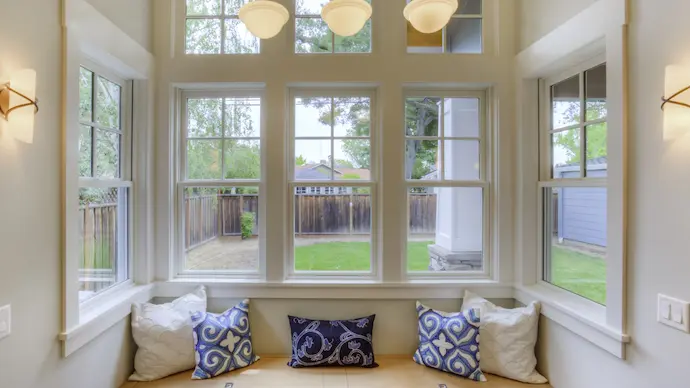
Window Type
The type of window you choose has one of the most significant effects on the cost. Standard double-hung or casement windows tend to be the most affordable, while bay or bow windows are more expensive due to their size and complexity.
TABLE
Window Size
Bigger windows naturally cost more. A small bedroom window will be cheaper to replace than a large picture window or a sliding glass door.
TABLE
Glass Size and Type
Energy-efficient glass is a popular choice because it helps reduce energy bills. However, opting for double or triple-pane glass, Low-E coatings, or gas-filled windows will increase the average price for window replacement.
TABLE
Frame Material
Different materials come with varying price tags. Vinyl windows are often the most cost-effective option, while wood and fiberglass windows are typically more expensive due to their durability and aesthetic appeal.
TABLE
Brand
The brand you choose can greatly impact the window replacement cost, quality, and features. Different manufacturers offer various styles, materials, and performance levels. Here are some of the top replacement window brands:
-

Andersen Windows:
Known for high-quality wood and composite windows, Andersen is a premium brand offering durable, energy-efficient windows. Their windows are often customizable with various finishes and hardware. Price Range: $800 – $2,500 per window.
-

Pella Windows:
Pella offers a wide range of windows in vinyl, wood, and fiberglass. They are known for their energy-efficient glass options and stylish designs. Pella windows are available in several series to meet different budget levels. Price range: $600 – $2,000 per window.
-

Marvin Windows:
This brand focuses on high-end wood and fiberglass windows. Marvin’s windows are known for their superior craftsmanship, energy efficiency, and customizability, making them a popular choice for luxury homes. Price range: $1,000 – $3,500 per window.
-

Milgard Windows:
Offering affordable vinyl, fiberglass, and aluminum windows, Milgard is known for its durability and energy-efficient designs. They offer a wide range of styles, making them a good option for budget-conscious homeowners. Price range: $400 – $1,500 per window.
-

Simonton Windows:
A solid mid-range option, Simonton specializes in vinyl windows that offer good energy efficiency and durability at an affordable price. Their windows come in various styles and colors. Price range: $300 – $900 per window.
-

Jeld-Wen Windows:
Jeld-Wen provides vinyl, wood, and aluminum windows at various price points. They are known for offering a broad selection of styles and materials, making them a versatile choice for different budgets and preferences. Price range: $400 – $1,500 per window.
-

Harvey Windows:
A regional favorite, Harvey manufactures high-quality vinyl and wood windows, primarily available in the northeastern U.S. Their windows are known for energy efficiency and reliable performance. Price range: $450 – $1,200 per window.
-

Alside Windows:
Offering budget-friendly vinyl windows, Alside is known for its affordability and basic energy efficiency. While their windows may lack the premium features of higher-end brands, they are a good value for standard home replacements. Price range: $250 – $800 per window.
Each brand offers unique features and typical costs to replace windows, so it’s essential to consider your priorities—whether it’s energy efficiency, style, or budget.
Location and Accessibility
Where the window is located matters, too. Ground-floor installations are much easier (and cheaper) than those on upper floors. Difficult-to-reach areas, like over a stairwell or on a steep roof, require special equipment and more labor, driving up costs.
 Easy-to-reach ground floor$100 – $400 per window
Easy-to-reach ground floor$100 – $400 per window Upper floors or difficult locationsAdd $200 – $800 per window
Upper floors or difficult locationsAdd $200 – $800 per window
Installation Complexity
Not all installations are the same. If your current window frames are in good shape, you might only need a straightforward replacement. However, if there’s damage or custom fitting required, the labor cost increases.
 Basic installation$100 – $300 per window
Basic installation$100 – $300 per window Custom installation or structural repairs$300 – $1,000 per window
Custom installation or structural repairs$300 – $1,000 per window
Labor Costs
Labor costs to remove and replace windows vary by region. If you live in an area with a higher cost of living or where skilled labor is in demand, expect to pay more for professional installation.
 Low-cost areas$150 – $400 per window
Low-cost areas$150 – $400 per window High-cost areas$400 – $1,200 per window
High-cost areas$400 – $1,200 per window
Permits and Inspections
Some regions require building permits for window replacements, especially if you’re altering the size or shape of the window. In addition, an inspection may be necessary to ensure the work meets local building codes.
 Permits$50 – $300 depending on your location
Permits$50 – $300 depending on your location Inspection fees$100 – $300
Inspection fees$100 – $300
Home Size and Number of Windows
The size of your home and the number of windows you need to replace directly affect the total cost. Larger homes with more windows will naturally have higher overall costs. Here’s a window replacement estimate based on typical home sizes:
-

Small Home (10–15 windows):
Typically includes smaller houses or apartments, where fewer windows are needed. Price Range: $3,000 – $12,000
-

Medium Home (15–30 windows):
Standard-size homes with more windows, including living rooms, bedrooms, and kitchens. Price Range: $7,500 – $25,000
-

Large Home (30+ windows):
Larger homes or properties with extensive window coverage, such as luxury homes or multi-story houses. Price Range: $15,000 – $60,000+
Additional Costs and Considerations
-

Structural Repairs
Sometimes, replacing windows isn’t just about swapping old ones for new ones. If there’s rot, mold, or damage to the window frames or surrounding walls, you’ll need to repair that first. This can add anywhere from $300 to $1,500 or more to your total window replacement cost, depending on the extent of the damage.
-

Energy Efficiency Upgrades
Want to save on energy bills in the long run? Investing in energy-efficient upgrades like Low-E coatings or gas-filled panes will cost more upfront but can deliver savings over time. These upgrades add $50 to $200 per window to the typical cost to replace windows but could reduce your utility costs significantly.
-

Old Window Removal and Disposal
Removing your old windows and properly disposing of them isn’t free. Some contractors will include this in their service, while others charge extra. Expect to pay around $50 to $150 per window for removal and disposal, depending on the number and size of the windows.
-

Upgrading Hardware and Screens
While some windows come with basic hardware, upgrading to premium handles, locks, and screens can increase costs. High-end hardware can range from $50 to $200 per window, and custom or retractable screens may add $100 to $400 each.
-

Weatherproofing and Exterior Work
If you live in an area with harsh weather conditions, adding extra weatherproofing can be crucial. This might include sealing around the window, reinforcing insulation, or adding exterior cladding, all of which can add $300 to $1,000 or more depending on your needs.
-

Window Insulation and Sealing
Proper insulation and sealing are crucial to ensuring that your windows perform efficiently. Professional caulking and insulating can cost $100 to $300 per window but is well worth it to prevent drafts and energy loss.
-

Warranty and Maintenance Costs
Most windows come with warranties, but not all are created equal. Premium warranties, which cover parts and labor for extended periods, may cost more initially. Also, consider long-term maintenance, especially for wood windows that need periodic painting or sealing. These costs can add $100 to $500 per year for ongoing upkeep, depending on the materials and frequency of maintenance.
-

Custom Work and Modifications
If you’re upgrading your window size or shape, expect additional charges for resizing or altering the window openings. For example, turning a standard window into a bay window could set you back an extra $1,000 to $5,000 due to the structural work required.
Ways to Finance Your Window Replacement Project
Okay, let’s talk money. Window replacement is an investment, but don’t let the cost scare you away. There are plenty of financing options out there to make it work for your budget.
Dip into your savings
This is the most straightforward option. If you’ve got the cash on hand, you can avoid interest payments and get those shiny new windows installed right away. Plus, there’s a certain satisfaction in paying for something outright, isn’t there?
Home Equity Loans or Lines of Credit (HELOCs)
If you’ve built up equity in your home, you might be able to tap into it for your window project. These loans often have lower interest rates than other options because your home serves as a financial provision.
-

Home Equity Loan:
You get a lump sum upfront and make fixed payments over time. It's great if you know the exact cost of replacing windows in the house.
-

HELOC:
It's like a credit card for your home equity. You can borrow as needed during a set “draw period” and then repay during the “repayment period.” This offers flexibility if your project costs are uncertain.
Personal Loans
These loans are unsecured, meaning they don’t require collateral. They can be a good choice if you don’t have enough equity in your home or prefer not to use it. Interest rates might be higher than home equity loans, but they can still be manageable.
Credit Cards
This can be a convenient option if you have a card with a low interest rate or a 0% introductory APR offer. Just be sure you can pay off the balance before the interest rate jumps up.
Government Programs and Incentives
Depending on where you live, there might be government programs or tax incentives to help offset the cost of installing replacement windows. Do some research to see available options in your area.
Manufacturer Financing
Some window companies offer financing plans, sometimes even with 0% interest for a promotional period. This can be a helpful option if you want to keep everything streamlined with one company.
Cash-Out Refinance
If you have a good amount of equity in your home, you could refinance your mortgage for a larger amount and take the difference in cash. This can be a way to get a lower interest rate on your overall debt. However, it’s important to weigh the costs and benefits carefully. Remember: It’s always wise to compare offers from multiple lenders and consider factors like interest rates, fees, and repayment terms before making a decision.
Money Saving Tips on Replacement Windows Project
Ready to upgrade your windows without breaking the bank? Let’s dive into some savvy strategies that’ll help you reduce costs:
-

Time Your Purchase Right:
Did you know window prices fluctuate throughout the year? Aim to buy during the off-season, typically late fall or winter. Many companies offer discounts of 10-20% during these slower months.
-

Get Multiple Quotes:
Don't settle for the first window replacement estimate you receive. Compare at least three quotes from different companies. This comparison shopping can often save you 10-15% of your total project cost.
-

Consider Energy-Efficient Options:
Energy-efficient windows might cost more upfront. At the same time, they guarantee significant long-term savings. According to Energy Star, you could save $101-$583 per year on energy bills. Plus, you might qualify for tax credits or rebates, potentially saving an additional $200-$500.
-

Skip the Excessive Features:
Do you really need that fancy between-the-glass blinds feature? Opting for simpler designs without high-end add-ons can cut costs by 5-10%.
-

Choose Your Window Material Wisely:
While wood windows look great, they're often the priciest option. Consider vinyl or fiberglass alternatives. They're durable and low-maintenance. The cost of vinyl replacement windows installed can be 10-30% cheaper than wood.
-

Don't Replace What You Can Repair:
Before you replace all your windows, have a professional assess them. Some might just need minor repairs or weatherstripping. Repairing instead of replacing even a couple of windows could save you $500-$1,000 or more.
-

DIY Where You Can:
While it's best to leave the actual window installation to the pros, you can save on labor costs by doing some prep work yourself. Removing old window treatments or trim can save you $25-$50 per window in labor costs.
-

Consider Partial Replacement:
If some windows are in good condition, replace a part of your windows. This approach could cut your project cost by 30-50%, depending on how many windows you're able to keep.
-

Look for Package Deals:
Many window companies offer discounts if you replace all your windows at once. These package deals can often save you 5-10% on the total project cost.
-

Negotiate:
Don't be afraid to ask for a better deal. Many companies have wiggle room in their pricing. By negotiating, you might score an additional 5-10% discount.
-

Stick to Standard Sizes:
Custom-sized windows can inflate your costs significantly. If possible, opt for standard sizes. This choice alone can save you 10-15% per window.
-

Explore Financing Options:
If you need to finance your project, shop around for the best rates. A difference of even 1-2% in interest rates can save you hundreds over the life of the loan. For instance, on a $15,000 loan over 5 years, a 2% lower interest rate could save you about $800 in interest payments.
Professional Window Replacement or Doing Yourself
TABS
Need help finding a pro? Check out Homebuddy.com. It’s an online platform that connects homeowners with trusted local contractors. You can easily browse reviews, compare average prices for window replacement, and book services—all in one place!
All professionals on Homebuddy.com are pre-screened and verified, so you know you’re getting a qualified expert. Just input your project details, and the platform will connect you with suitable professionals. No need to spend hours researching contractors—Homebuddy.com does it for you.
Beyond Homebuddy.com, here are a few more tips for finding a reliable window installer:
-

Tap into your network—friends, family, or neighbors—to see if they have any recommendations.
-

Make sure the contractor is licensed and insured to protect themselves from liability.
-

Don't settle for the first quote you receive. Instead, Compare offers from several contractors.
-

Ask about warranties. A good company will stand behind its work with a solid warranty.
What Should You Ask a Pro?
When hiring a window replacement professional, asking the right questions is essential to ensure quality service and products. Here are key questions to consider:
-

Experience and Credentials:
How long have you been running your business? Can you provide references or examples of past projects?
-

Installation Process:
Who will perform the installation? Are they employees or subcontractors? How long will the installation take, and how will the weather affect the timeline?
-

Materials and Products:
What types of windows do you offer, and what are their specifications? What materials will be used for installation (e.g., caulk, screws)?
-

Costs and Pricing:
Can you provide a detailed quote, including labor and material costs? What are your payment terms, and do you require a deposit?
-

Warranties and Insurance:
What warranties do you offer for windows and installation? Do you have liability insurance and worker’s compensation coverage?
-

Preparation and Cleanup:
What must I do to prepare for installation? How will you protect my home during the installation, and what is your cleanup process?
Conclusion
Replacing your windows is a significant investment, but one that can greatly enhance your home’s comfort, energy efficiency, and curb appeal. While window replacement costs can vary widely based on different factors, being well-informed helps you make the best decision.
Remember, the cheapest option isn’t always the most cost-effective in the long run. By carefully considering your needs, exploring financing options, and choosing a reputable professional, you can ensure your window replacement project adds lasting value to your home.
Frequently Asked Questions
Can replace my windows save money on energy bills?
Absolutely! High-quality, energy-efficient windows can significantly reduce your heating and cooling costs. According to the Department of Energy, heat gain and loss through windows account for 25% to 30% of residential heating and cooling energy use. Investing in energy-efficient windows can lead to substantial savings over time.
Is it worth replacing all windows at once?
Replacing all your windows at once can save you money in the long run. Doing so can provide uniform energy efficiency and aesthetic appeal throughout your home. Additionally, many contractors offer discounts for bulk installations, which can lower the overall cost per window.
How much does it cost to replace 25 windows?
On average, replacing 25 standard windows could range from $7,500 to $37,500. If you choose energy-efficient or custom windows, the price may go even higher.
How long do replacement windows typically last?
The lifespan of your windows depends on the material and quality. Vinyl windows typically last 20–40 years, while wood windows can last 30+ years with proper maintenance. Fiberglass windows boast an impressive lifespan of up to 50 years!
What is the most suitable time to replace my windows?
While you can replace windows anytime, consider scheduling your project during the off-season (typically winter). Many companies offer discounts during slower periods, and you might even get bumped to the front of the line!
